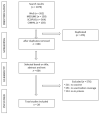Vaccination Coverage among Prisoners: A Systematic Review
- PMID: 33086513
- PMCID: PMC7589151
- DOI: 10.3390/ijerph17207589
Vaccination Coverage among Prisoners: A Systematic Review
Abstract
Prison inmates are highly susceptible for several infectious diseases, including vaccine-preventable diseases. We conducted a systematic international literature review on vaccination coverage against hepatitis B virus (HBV), hepatitis A virus (HAV), combined HAV/HBV, tetanus-diphtheria, influenza, pneumococcal, and combined measles, mumps, and rubella (MMR) in prison inmates, according to the PRISMA guidelines. The electronic databases were used Web of Science, MEDLINE, Scopus, and Cinhal. No language or time limit were applied to the search. We defined vaccination coverage as the proportion of vaccinated prisoners. There were no limitations in the search strategy regarding time period or language. Of 1079 identified studies, 28 studies were included in the review. In total, 21 reported on HBV vaccine coverage (range between 16-82%); three on HAV (range between 91-96%); two studies on combined HAV/HBV (77% in the second dose and 58% in the third); three studies on influenza vaccine (range between 36-46%), one of pneumococcal vaccine coverage (12%), and one on MMR coverage (74%). We found that data on vaccination coverage in prison inmates are scarce, heterogeneous, and do not include all relevant vaccines for this group. Current published literature indicate that prison inmates are under-immunized, particularly against HBV, influenza, MMR, and pneumococci. Strengthen immunization programs specifically for this population at risk and improvement of data record systems may contribute to better health care in prisoners.
Keywords: immunization programs; inmates; prisoners; vaccination coverage.
Conflict of interest statement
The authors declare no conflict of interest.
Figures
Similar articles
-
Immunization Coverage of Inmates in Spanish Prisons.Int J Environ Res Public Health. 2020 Oct 31;17(21):8045. doi: 10.3390/ijerph17218045. Int J Environ Res Public Health. 2020. PMID: 33142883 Free PMC article.
-
Age-appropriate versus up-to-date coverage of routine childhood vaccinations among young children in Israel.Hum Vaccin Immunother. 2017 Sep 2;13(9):2102-2110. doi: 10.1080/21645515.2017.1341028. Epub 2017 Jul 11. Hum Vaccin Immunother. 2017. PMID: 28696824 Free PMC article.
-
Vaccination coverage among children enrolled in Head Start programs or day care facilities or entering school.MMWR CDC Surveill Summ. 2000 Sep 22;49(9):27-38. MMWR CDC Surveill Summ. 2000. PMID: 11016876
-
Vaccinations in prison settings: A systematic review to assess the situation in EU/EEA countries and in other high income countries.Vaccine. 2019 Aug 14;37(35):4906-4919. doi: 10.1016/j.vaccine.2019.07.014. Epub 2019 Jul 18. Vaccine. 2019. PMID: 31327651
-
Successes and challenges for preventing measles, mumps and rubella by vaccination.Curr Opin Virol. 2019 Feb;34:110-116. doi: 10.1016/j.coviro.2019.01.002. Epub 2019 Mar 7. Curr Opin Virol. 2019. PMID: 30852425 Review.
Cited by
-
Knowledge, attitudes, and behavior of incarcerated people regarding COVID-19 and related vaccination: a survey in Italy.Sci Rep. 2022 Jan 19;12(1):960. doi: 10.1038/s41598-022-04919-3. Sci Rep. 2022. PMID: 35046470 Free PMC article.
-
Cancer-preventing vaccination programs in prison: promoting health equity in Europe.Lancet Reg Health Eur. 2024 Jun 19;43:100958. doi: 10.1016/j.lanepe.2024.100958. eCollection 2024 Aug. Lancet Reg Health Eur. 2024. PMID: 39210943 Free PMC article. Review.
-
Vaccination against emerging and reemerging infectious diseases in places of detention: a global multistage scoping review.Front Public Health. 2024 Jan 29;12:1323195. doi: 10.3389/fpubh.2024.1323195. eCollection 2024. Front Public Health. 2024. PMID: 38347924 Free PMC article.
-
Seroprevalence and factors associated with hepatitis B virus exposure in the incarcerated population from southern Brazil.PLoS One. 2022 Nov 22;17(11):e0278029. doi: 10.1371/journal.pone.0278029. eCollection 2022. PLoS One. 2022. PMID: 36413542 Free PMC article.
-
Acceptance of the COVID-19 Vaccine by Prisoners and Staff in Spanish Prisons.Vaccines (Basel). 2023 Sep 29;11(10):1547. doi: 10.3390/vaccines11101547. Vaccines (Basel). 2023. PMID: 37896950 Free PMC article.
References
-
- The World Prison Brief. [(accessed on 1 July 2020)]; Available online: https://www.prisonstudies.org.
-
- European Centre for Disease Prevention and Control . Systematic Review on Hepatitis B and C Prevalence in the EU/EEA. European Centre for Disease Prevention and Control; Stockholm, Sweden: 2016.
-
- European Centre for Disease Prevention and Control. European Monitoring Centre for Drugs and Drug Addiction . Public Health Guidance on Prevention and Control of Blood-Borne Viruses in Prison Settings. ECDC; Stockholm, Sweden: EMCDDA; Stockholm, Sweden: 2018.
-
- Aebi M., Chopin J., Tiago M.M., Burkardt C. SPACE I—C. Council of Europe; Strasbourg, France: 2018. [(accessed on 13 May 2020)]. Available online: http://wp.unil.ch/space/space-i/prison-stock-on-1st-january/2018-2/
Publication types
MeSH terms
Substances
LinkOut - more resources
Full Text Sources


